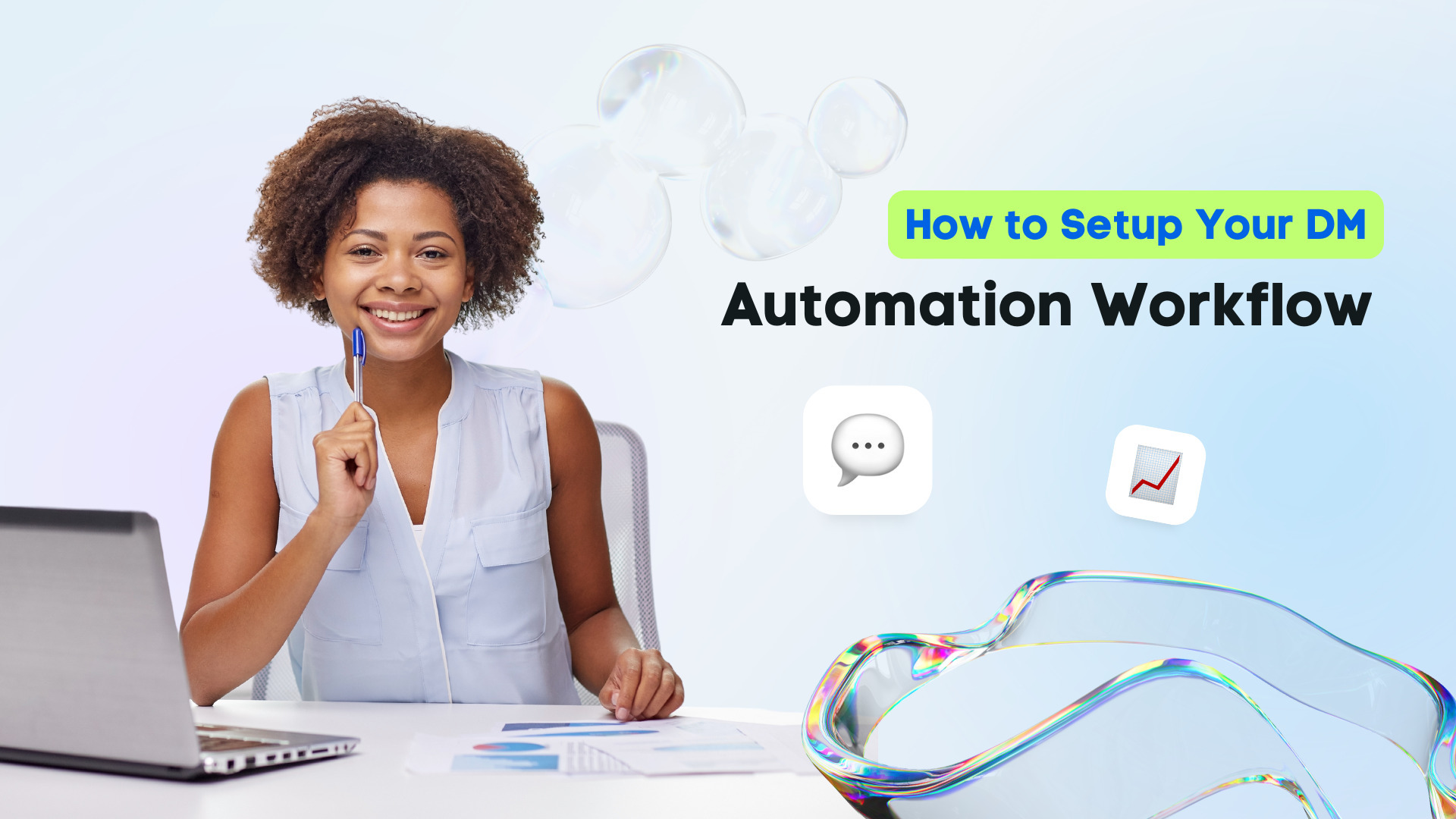Learning how to set up your DM automation workflow?
We’ve got you covered.
Manually managing your clients’ DMs can take A LOT of time and effort.
The good news?
You can automate your clients’ social media Direct Messages (DMs) by setting up solid workflows.
Automated Direct Message (DM) workflows can save precious work hours while boosting your clients’ engagement and improving customer service delivery.
In this guide, we’ll walk you through the steps to set up a smooth and effective DM automation workflow.
Let’s dive right in.
What you will learn
- How to set up your DM automation workflow: Easy steps and methods
- Common mistakes to avoid when learning how to set up your DM automation workflow
- FAQs on how to set up your DM automation workflow
- Ready to build a DM automation workflow that works while you sleep?
How to set up your DM automation workflow: Easy steps and methods
Setting up your DM automation workflow is quick and easy with the steps and tips below.
Step 1. Determine your goals
Before you build anything, you should be crystal clear on the purpose of your Facebook, LinkedIn, or Instagram DM automation.
Must read: Top LinkedIn Automation Tools for Lead Generation
Ask yourself (and your client): What do we want the DMs to achieve?
Your goals can include:
- Collecting leads by capturing emails or phone numbers
- Welcoming new followers with a friendly message and an introduction to your clients’ brands
- Providing quick customer support by answering Frequently Asked Questions (FAQs) or directing them to your clients’ official support links
- Promoting offers or content, such as free resources, new products, or discounts
- Qualifying leads before passing them to your clients’ human sales agents
Consider prioritizing these goals to help you get a clearer direction.
If you have multiple goals, you may need multiple workflows or slightly different triggers and responses for each.
Having clear goals makes your clients’ Facebook or Instagram DMs sharper and your automation smarter.
Step 2: Map out common DM scenarios
Next, it’s time to get inside the heads of your clients’ audiences.
Start by listing the types of DMs your clients’ brands or clients’ social media accounts already get, such as:
- Questions about pricing or packages
- Shipping and returns queries
- Complaints or service issues
- Product recommendations
- Requests for partnerships or collaborations
You can sort these DM types into two buckets:
- Simple, repetitive questions, which can be good candidates for automation
- Complex, emotional, or sensitive issues, which a human handles better
Remember, you want your automation to handle straightforward tasks while allowing easy handoff to a real person when things get tricky.
The key is creating a flowchart or mind map to visualize how various DMs should be routed.
Step 3: Write your automated messages
Now for the fun part—writing your DM scripts.
Ensure that you set up automated messages that are:
- Friendly and welcoming, and not too stiff or salesy
- Clear and concise, with no long paragraphs
- On-brand and uses the same tone your clients use in their Facebook posts, Instagram Stories, and other social media content
- Personalized when possible (includes the user’s name, if allowed by your clients’ social media platforms)
Must read: How to Automate Social Media Posts: w/ Tools & Tips
Below are a few best practices you can follow when writing your DM scripts.
- Start with a warm greeting
- Acknowledge the user’s action, such as following your clients’ pages or profiles, or asking a question
- Offer clear next steps—don’t leave them hanging
- Keep your messages casual but professional
Here’s a sample automated DM script:
“Hey [First Name]! 👋 Thanks for reaching out. Reply with a number: 1️⃣ if you want to know about pricing, 2️⃣ if you need customer support, or 3️⃣ if you want to see our latest offers.”
Vista Social can make writing your DM script quicker and easier.
The social media management platform offers an AI Assistant that streamlines responding to reviews, mentions, comments, and DMs via the smart Social Inbox.
Must read: When to Automate Social Media
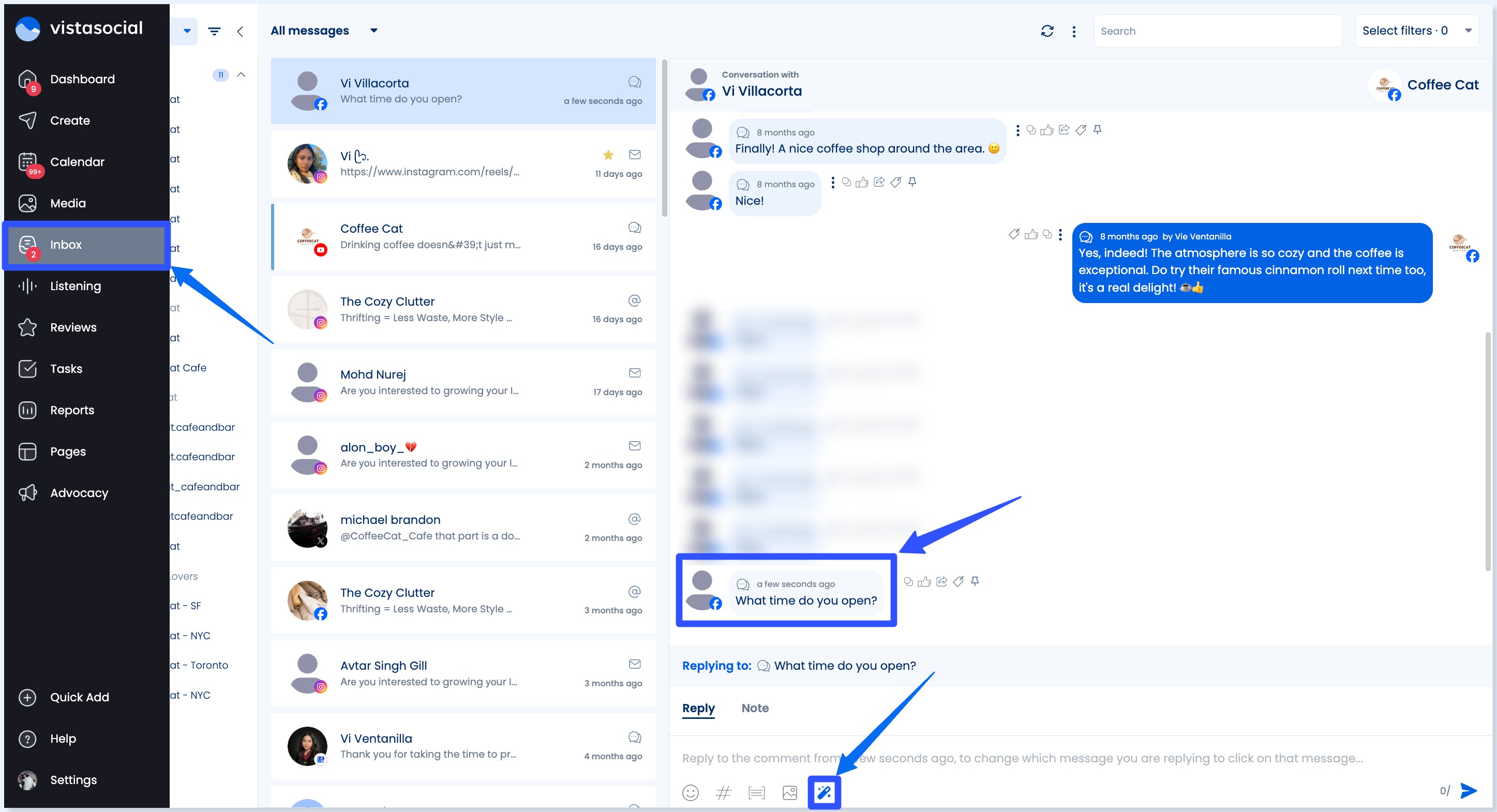
Click the AI Assistant option at the bottom to instantly generate a response.
You can write a reply for the AI Assistant to refine in Guided Mode.
You can also set the tone, format, and brand voice (which you can pre-set).
The AI Assistant will quickly generate a refined version (or versions) of your text, which you can save and send as a reply to an interaction, improving the customer experience.
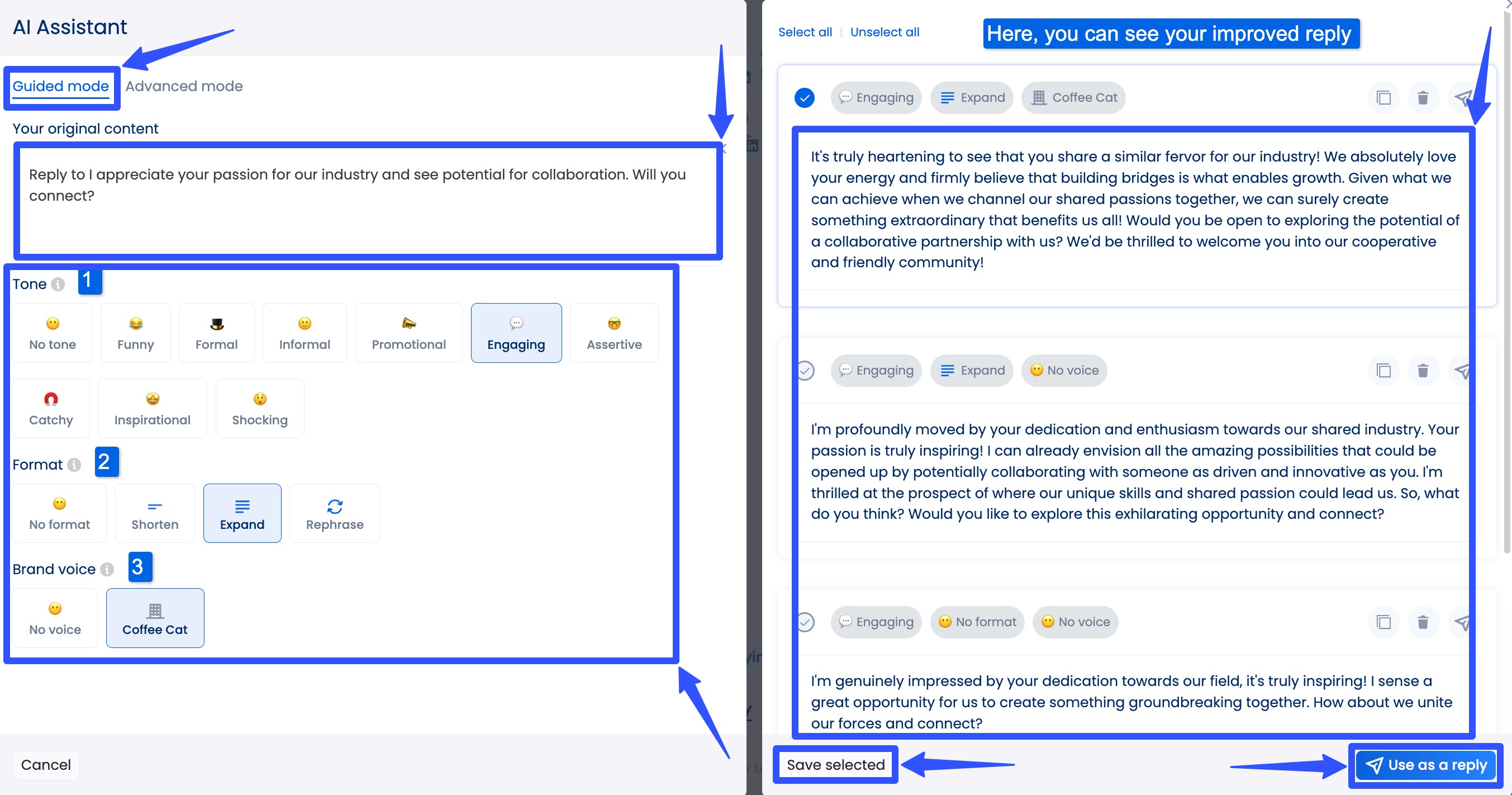
In Advanced Mode, you can write a description of the response you want to create (prompt), and the AI Assistant will generate replies.
You can choose one to use as a reply.
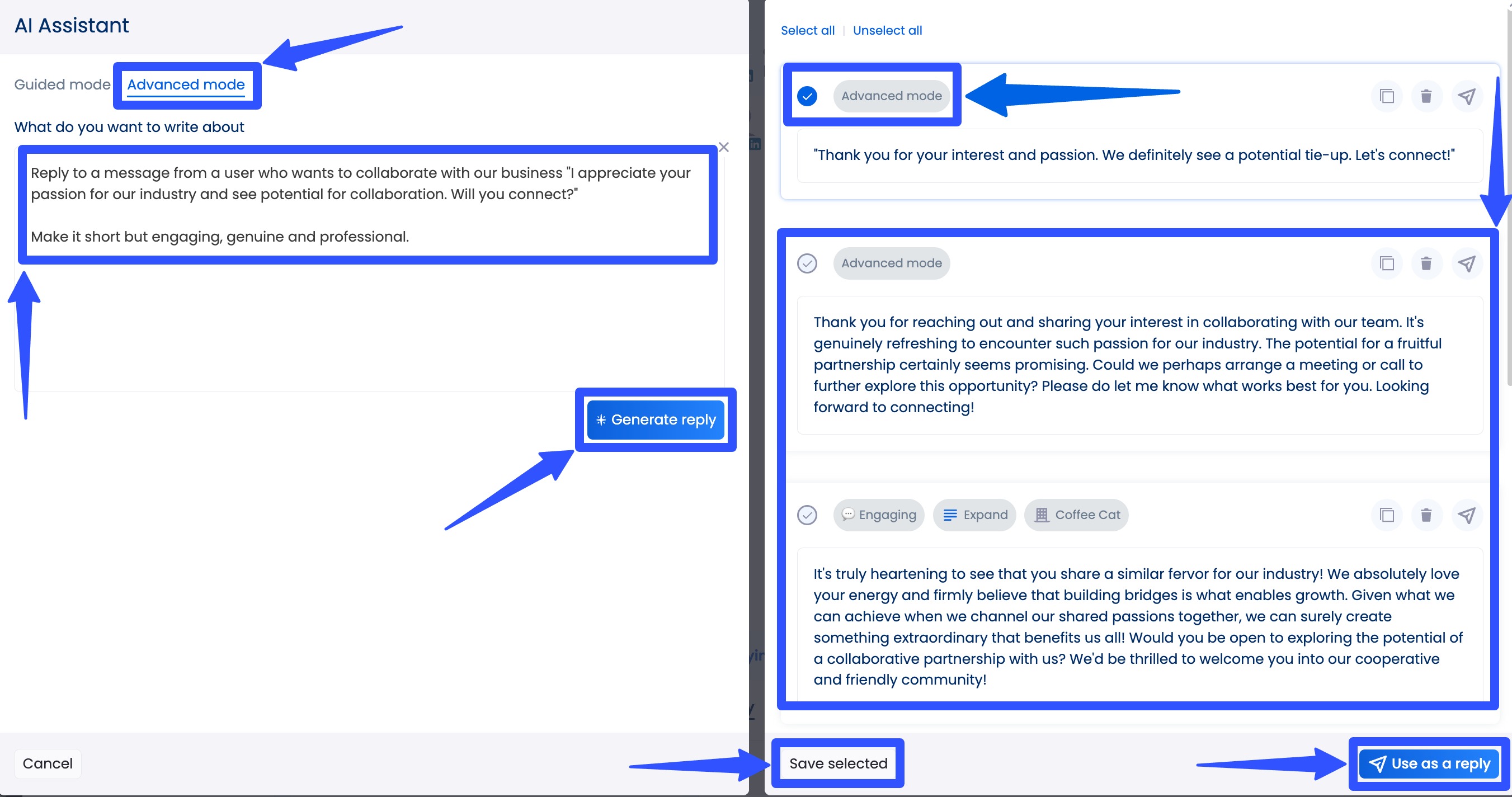
If you’re responding to a common question, you can save the generated response for future use by clicking Save selected.
With Vista Social’s AI Assistant, you can cut down your response time by more than half, ensuring prompt handling.
The platform offers more automation tools, including automated approval workflows, report scheduling, post scheduling, and more.
Must read: How to Create Automated Social Media Reports
But wait! There’s more.
Vista Social now offers DM automations to streamline your workflow further and save time.
The platform’s DM automation feature helps you spark conversations, drive traffic, or grow your clients’ followers.
Setting up your DM automation workflow on Vista Social is pretty quick and easy (more on this below).
Step 4: Set up triggers and flows
After writing your DM scripts, you can start building the automation logic.
Triggers are the actions that start the automation, which can be the following.
- Someone sends a DM with a specific keyword, such as “pricing” or “help”
- A user follows your client’s Instagram or Facebook accounts
- A person clicks a sticker or responds to your client’s Story
Once your triggers are set, design your flow by mapping out the user’s journey based on their response.
Think of it like a conversation tree with each choice leading to another message, and so on.
Also, always include an escape hatch, such as typing ‘Human’ to speak with a team member.
Additional tip: Keep your flows short and simple at first.
Don’t overwhelm new followers with ten questions right away. The goal is to give them quick wins that get them what they want.
To set up your DM automation on Vista Social, start by naming your automation and selecting the social media profile you’re creating it for.
Next, choose your trigger.
It can be:
- A comment on post or reel
- A comment on a Live
- A direct message
- A Story reply

Set the keyword or keywords, such as info or link, that will trigger your DM automation.

Important: When setting up comment triggers, you must choose if they apply to a specific, Reel, or all your clients’ posts.

Now that you have your triggers, it’s time to set up your actions (what happens once the triggers are set off).
The actions can vary based on the social media platform like this:
Instagram:
- If your trigger is a DM, your actions can be sending a DM (text with optional image, video, link, or card)
- If your trigger is a comment, your actions can be replying with a comment (text only) or responding with a DM (text, image, video, optional link, or card)
Facebook:
- If your trigger is a DM, your actions can be sending a DM (text with optional link, image, video, or card)
- If your trigger is a comment, your actions can be replying with a comment (image, video, or text) or responding with a DM (optional link, image, video, text, or card)
You can also set up automated Opening DMs that enables you to unlock multi-step messaging for Instagram users.
With this feature, you can include a button in your DM reply to a comment that, once clicked, enables a two-way conversation.
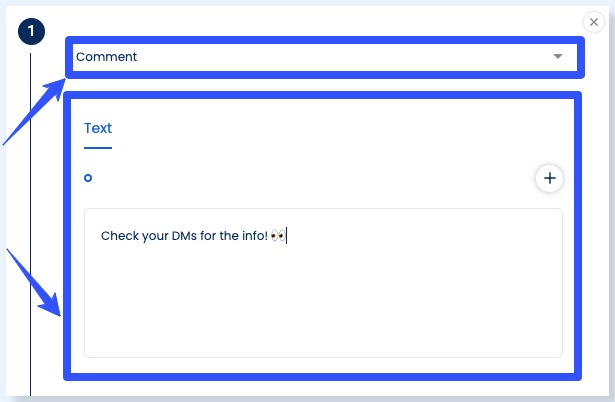
You can use this to automate sending your clients’ offers, follow-ups, and other messages.
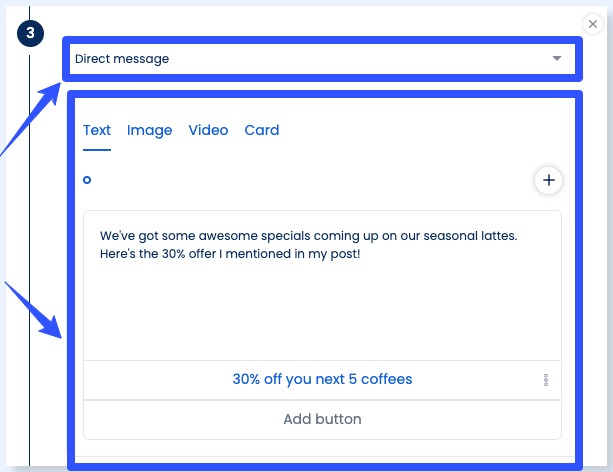
When using the text actions, you can type in your message and use the Add variation option to get various versions.
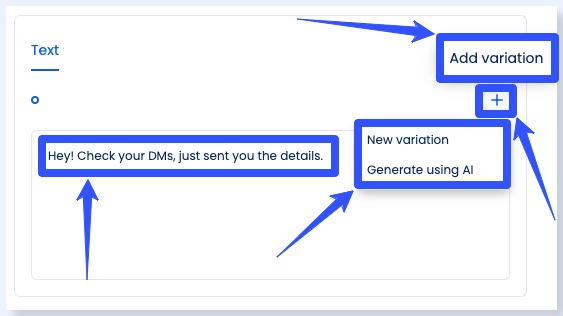
You can also use the AI feature to generate texts/messages for you.
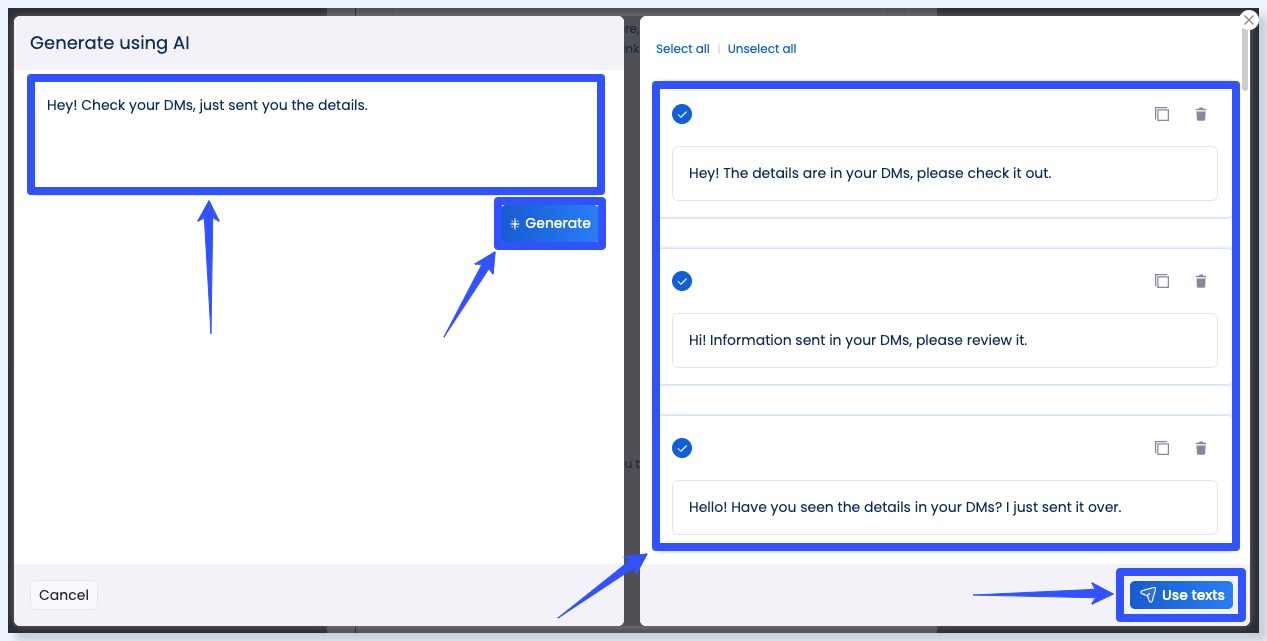
Another handy DM automation feature from Vista Social is its ready-to-use templates for auto-DM links for comments.
Start by creating a new automation.

Select your template: Auto-DM links from comments.
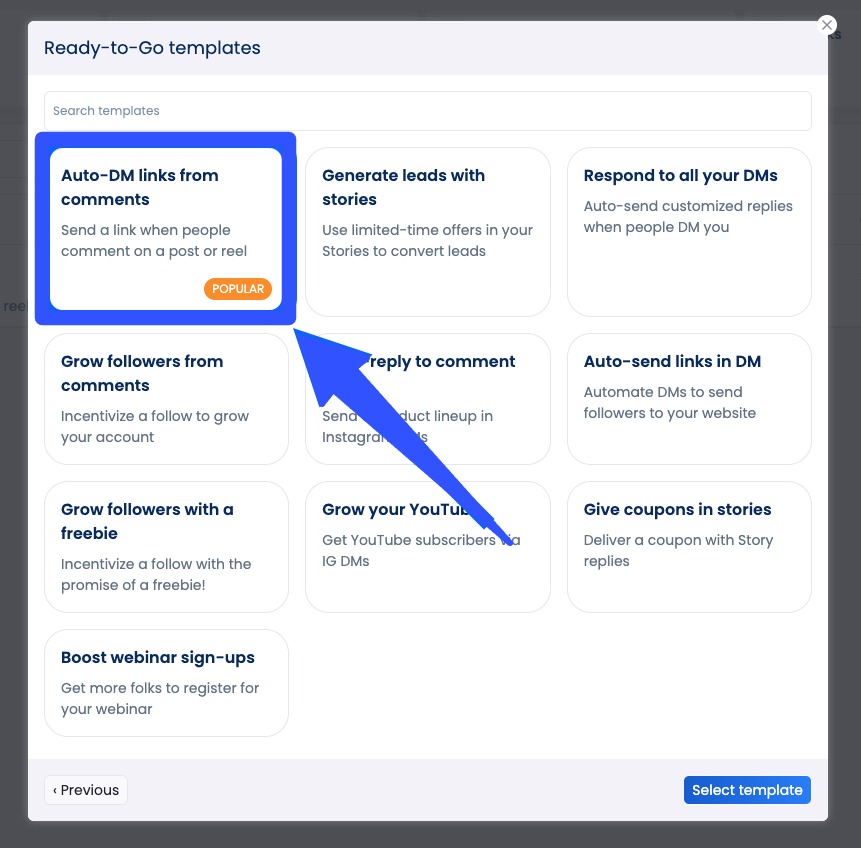
Other templates include:
- Custom, auto-send replies
- Auto-reply to a comment with a product lineup on Instagram
- Auto-send links in DM
Select the Instagram or Facebook profile.

From here, you can:
- Choose your triggers
- Set the trigger comment (if applicable)
- Set the automation to be available only to your clients’ followers
- Create a custom message. It can be a message to encourage recipients to follow your clients’ profiles
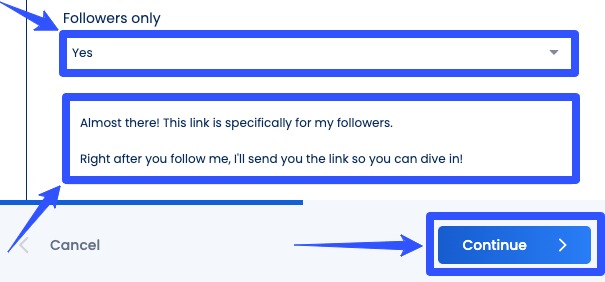
Click Continue, and you’re all set.
Step 5: Test your automation
Never launch an automation without testing it first, and maybe even twice.
Look for the following when testing your DM automation workflow.
- Are all triggers working correctly?
- Are the messages clear and easy to understand?
- Are the links clickable and going to the right places?
- Is the personalization working correctly, such as using the first name?
- Does the flow feel natural, or are there awkward dead ends?
If possible, test from the user’s perspective on both mobile and desktop. Depending on the device people use when sending DMs to your clients, things can feel different.
Have someone else on your team test it too. Fresh eyes often catch things you may miss.
Step 6: Track and optimize
The work doesn’t stop just because your DM automation workflow is up and running.
You need to monitor your DMs’ performance and be prepared to make adjustments over time.
Track the following key metrics to measure performance.
- Open rates: Are people opening your clients’ automated messages?
- Response rates: Are users replying or clicking through?
- Drop-off points: Where are people ghosting or quitting the flow?
- Conversion rates: Are users taking the desired action, such as signing up, making a purchase, or clicking?
If many users drop off after the first message, it may be too vague or boring.
Maybe your prompts aren’t clear enough if they’re selecting the wrong option.
Tweak the wording, simplify the flows, and add FAQs—whatever it takes to keep the conversation flowing and maintain strong engagement.
Common mistakes to avoid when learning how to set up your DM automation workflow
Setting up DM automation can be a game-changer—but only if you sidestep some of the most common rookie mistakes.
Watch out for the following.
Overcomplicating your flows
Creating massive, intricate flows with dozens of paths and options is tempting.
But the truth is that simple is better.
Keep your DM automation workflows short, clear, and focused.
Too many options can overwhelm users and cause them to drop off.
Sounding too robotic
Nobody wants to feel like they’re talking to a machine.
Avoid stiff, formal language and long-winded responses.
Write your automated messages the same way you’d text a friend—friendly, warm, helpful, and to the point.
Ignoring human handoffs
Automation is amazing, but it can’t solve everything.
Always build in an easy way for users to get help from a real person when needed.
Whether it’s a “talk to support” option or a simple “type HUMAN to chat with our team,” ensure the door is always open for users to reach human reps.
FAQs on how to set up your DM automation workflow
Do you need special tools to automate DMs?
Most of the time, yes.
You’ll need either a social media management platform with a built-in DM automation tool or a specialized chatbot app that connects to your clients’ social media accounts.
Must read: Top Social Media Automation Tools for 2024
Can DM automation sound personal or will it feel robotic?
When done right, DM automation can feel personal.
Using friendly language, adding personalization, and keeping the tone on-brand can make your clients’ DMs feel like a natural extension of their social media presence, rather than a stiff, robotic interaction.
Is DM automation allowed on all platforms?
Most social media platforms allow DM automation, but with specific rules.
For example, Instagram and Facebook allow you to automate responses within a 24-hour window after user engagement.
Should you integrate a chatbot tool or use native features?
It depends on your clients’ and team’s needs:
- For basic auto-replies and FAQs, Instagram or Facebook’s native tools may be enough
- For multi-step flows, keyword triggers, comment-to-DM, or advanced routing, your best bet is to use third-party platforms such as Vista Social
Ready to build a DM automation workflow that works while you sleep?
Setting up your DM automation workflow can be easy with clear goals, a smart automation and marketing strategy, and the right tools.
Need a hand getting started?
Vista Social simplifies setting up powerful, human-sounding DM automations across all your clients’ social media platforms.
Besides DM automation, the platform offers sophisticated social media management features, including content scheduling, engagement management, and analytics and reports. Create your Vista Social account today.
